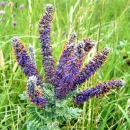About Us
Wetland Management Districts are little known but very important components of the National Wildlife Refuge System. Within wetland management districts, small parcels of land called Waterfowl Production Areas are purchased and managed by the US Fish & Wildlife Service to provide nesting habitat for waterfowl. These areas are concentrated where the ducks are - in the Prairie Pothole Region in the northern Great Plains. Today there are about 34,000 tracts protected as Waterfowl Production Areas which is about 2% of the Refuge System.
McCarlson Waterfowl Production Area, located in Day County, was the first parcel purchased in 1959. Since then, over 40,000 acres have been purchased in Waubay Wetland Management District for ducks and other wildlife. Funds to purchase waterfowl production areas come from the sale of Migratory Bird Hunting and Conservation Stamps, also known as Duck Stamps. Hunters over the age of 16 are required to purchase a stamp prior to hunting waterfowl. Nationwide, nearly 5 million acres of habitat have been protected with funds from Duck Stamp sales. These areas are open to hunting as well as other wildlife activities like birdwatching, trapping, and photography.
Money from Duck stamp sales and the Land and Water Conservation Fund are also used to purchase grassland and wetland easements which pay landowners to permanently protect grasslands and wetlands without relinquishing ownership. In South Dakota, half our wetlands and about 35% of grasslands have been lost to development and agriculture, and the loss continues. In the past decade more than 15,000 wetland acres per year have been drained in the state. Over one million acres of grass were plowed up in the western corn belt from 2006-2011. In South Dakota alone, 27,000 acres of native prairie were converted to cropland in just two years (2011-2012). Conservation easements are an effective way to preserve these vital habitats for wildlife and future generations of landowners, hunters, birdwatchers, anglers, and anyone that relies on our natural resources for the beauty, recreation, and ecosystem services they provide.
Our Mission
The Mission of the National Wildlife Refuge System is to administer a national network of lands and waters for the conservation, management, and where appropriate, restoration of the fish, wildlife, and plant resources and their habitats within the United States for the benefit of present and future generations of Americans.
Other Facilities in this Complex
A National Wildlife Refuge Complex is an administrative grouping of two or more refuges, wildlife management areas, or other refuge conservation areas that are primarily managed from a central office location. Refuges are grouped into a complex structure structure
Something temporarily or permanently constructed, built, or placed; and constructed of natural or manufactured parts including, but not limited to, a building, shed, cabin, porch, bridge, walkway, stair steps, sign, landing, platform, dock, rack, fence, telecommunication device, antennae, fish cleaning table, satellite dish/mount, or well head.
Learn more about structure because they occur in a similar ecological region, such as a watershed or specific habitat type, and have a related purpose and management needs. Typically, a project leader or complex manager oversees the general management of all refuges within the complex and refuge managers are responsible for operations at specific refuges. Supporting staff, composed of administrative, law enforcement, refuge manager, biological, fire, visitor services, and maintenance professionals, are centrally located and support all refuges within the complex.
Other refuges in the Waubay Complex include: Waubay National Wildlife Refuge and Dakota Tallgrass Prairie Wildlife Management Area.


